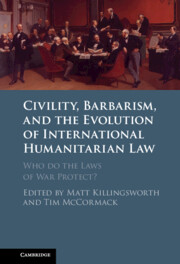 Civility, Barbarism and the Evolution of International Humanitarian Law
Civility, Barbarism and the Evolution of International Humanitarian Law Published online by Cambridge University Press: 11 January 2024
Accounts of the historical origins of international humanitarian law (IHL) routinely assume that the emergence of humanity as a constraint on the waging of war, coinciding as it did with a general rise of humanitarianism in the nineteenth century, reflected a growing commitment to a universally shared notion of human dignity. That assumption is fallacious. Those who have been mythologised as champions of humanity as constraint, including Henri Dunant and Francis Lieber, were products of their era. IHL’s ‘original sin’ was to only extend constraints of humanity to so-called civilised nations in their wars inter se. These same constraints were not intended to apply to indigenous and other colonised populations – those assumed to be ‘uncivilised’ – often referred to as such with the pejoratives ‘savages’ and/or ‘barbarians’. The exclusion of emergent constraints on the grounds of racism and colonialism is evident in the language of the early IHL treaties. It has taken many decades for the international community to overcome the exclusions of the legal protection of emergent IHL and some would argue that the tendency for exclusion is still evident in the dehumanising of the other in the Global War on Terror.
To save this book to your Kindle, first ensure no-reply@cambridge.org is added to your Approved Personal Document E-mail List under your Personal Document Settings on the Manage Your Content and Devices page of your Amazon account. Then enter the ‘name’ part of your Kindle email address below. Find out more about saving to your Kindle.
Note you can select to save to either the @free.kindle.com or @kindle.com variations. ‘@free.kindle.com’ emails are free but can only be saved to your device when it is connected to wi-fi. ‘@kindle.com’ emails can be delivered even when you are not connected to wi-fi, but note that service fees apply.
Find out more about the Kindle Personal Document Service.
To save content items to your account, please confirm that you agree to abide by our usage policies. If this is the first time you use this feature, you will be asked to authorise Cambridge Core to connect with your account. Find out more about saving content to Dropbox.
To save content items to your account, please confirm that you agree to abide by our usage policies. If this is the first time you use this feature, you will be asked to authorise Cambridge Core to connect with your account. Find out more about saving content to Google Drive.